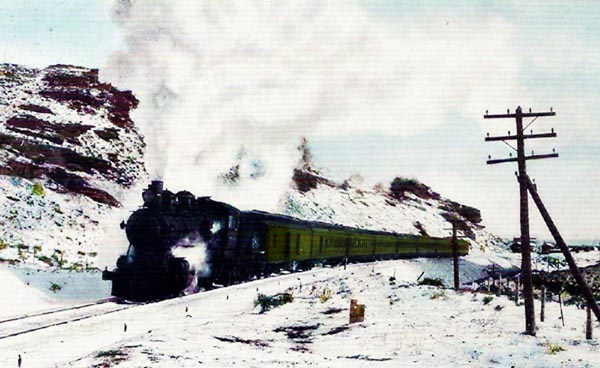
The Overland Limited,1909 heading west.
As previously noted, the period from about 1890 to the 1930's were the height of railroad
passenger service in the United States. It was the age of named trains. Cheyenne over the years was served at diferent times by the Overland Limited frunning from
San Francisco to Chicago. At the time it was the nation's most luxurious train. One could speed from San Francisco to
Chicago in only three days. Later the Overland Limited was downgraded and succeeded by the City of San Francisco,
the San Francisco Zephyr and the California Zephyr.
Early railroad songs were about the workmen and the engineers
who made those trains possible. Later those trains were recalled in the great hits of the 1930's and 40's,
the "Atchinson, Topoka and Santa Fe," "The Chattanooga Choo Choo" and the "Orange Blossom Special." One of the earliest of those
railroad songs played in the background is the 1911 victor Talking Machine Co. recording of "Railroad
Rag," perhaps inspired by the trip from Chicago to San Francisco on the Limited, words at the bottom of the page.
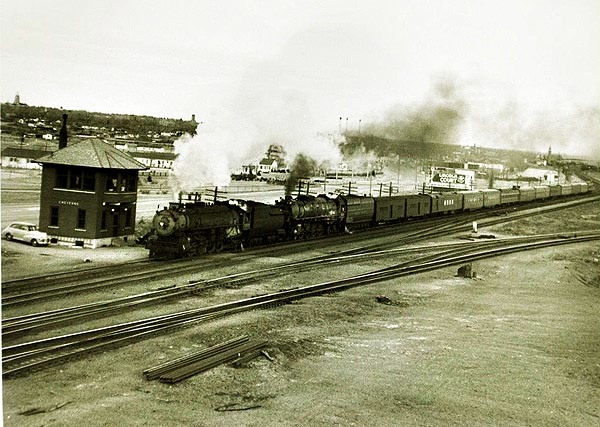
The Overland Limited, double-headed heading west out of Cheyenne, 1940's.
Double-heading was necessary. Approximately ten miles west of Cheyenne near Borie, the train will begin the ascent up Sherman Hill.
There is hardly anything at Borie. At the time of the photo, Borie consisted of little more that a
dispatch tower. The post office lasted only six years from 1895 to 1901. Nevertheless as discussed on the next page,
Borie in the 1980's would have great signficance for
passenger service in Cheyenne.
In the distance at the upper left of the photo may be seen the dome of the Capitol. On the right
is the Union Pacific Depot. Immediately above the dispatch tower is the Lincoln highway.
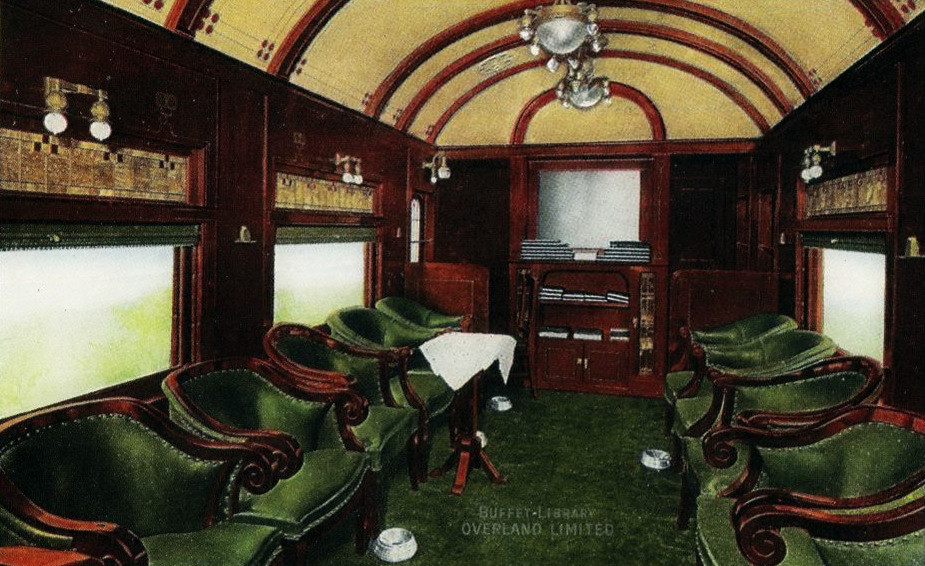
The Overland Buffet-Library Car, 1913. Note the four spittons on the floor.
The Overland Limited announced to the world that the Union Pacific was back. The train was equipped with a dining car, barbershop, a smoking car, and by 1902 equipped with electric
lights replacing the earlier naptha lighting used by most trains. The train had an electric
generator in the baggage car.
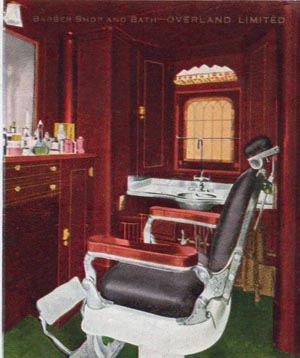 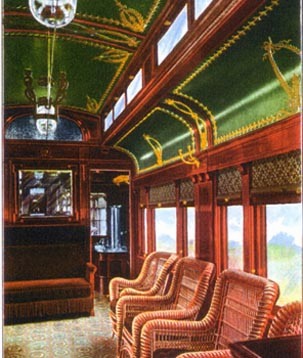 Left, Overland Limited, barber car; Right, Overland Limited smoking Car, approx. 1898.
Left, Overland Limited, barber car; Right, Overland Limited smoking Car, approx. 1898.
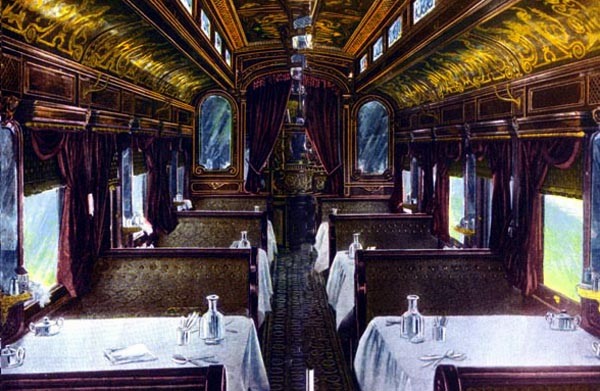
Dining Car, approx. approx. 1898.
Dining service on the Loverland Limited was equal to many of the finer hotels of the time. Everything was a la carte and maybe a bit pricy. Thousand Island
dressing for the salads was twenty cents. There was a choice of two soups, fish
included fillet of sole, finnen hadie "Overland Style," or broiled lake trout "maitre d'hotel,"
Entrees included a club steak, lamb steak, broiled squab with a rasher of bacon,
fried sping chicken (the most expensive item on the menu, $.80), veal cutlet Milanaise and spaghetti au graten.
Sides included corn on the cob, artichokes with butter, fried sweet potatos, and mashed potatoes. Desserts included
two different melons, baked apple with cream, and roquefort cheese.
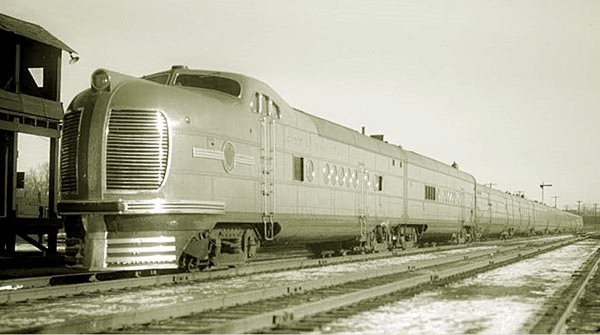
the City of San Francisco, 1936.
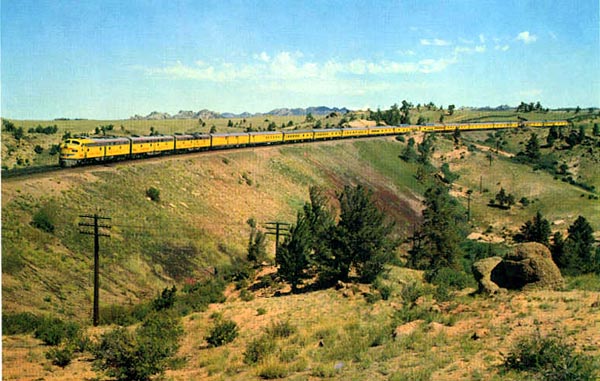
the City of Los Angeles, on the Sherman Hill fill, 1950.
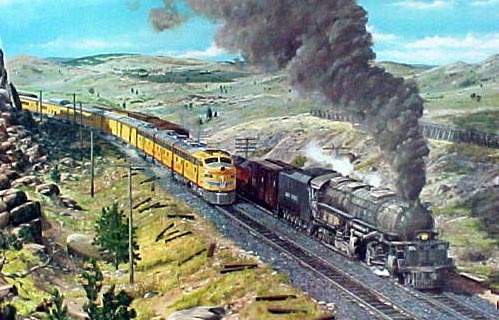
the City of Los Angeles, on the Dale Creek Embankment, undated.
In the above photo it is difficult to determine whether the City Of Los Angles is side-tracked while the freight passes. Most likely it
is.
Prior to World War I and the nationalization of the railroads passenger trains usually had priority except for
trains carrying perishable vegetables from California which customarity had priority. During
government operation of the railroad during the war, freight trains usually had prioity depending upon the freight carried.
Giving priority to a passenger train could delay as many as four freight trains. Equally important, a freight train including cars from other
railroads incurred a per diem rental for any "foreign" cars on its lines. The per diem ran from midnight to midnight. Thus, if a car from another railroad was on
the line at midnight an additional per diem charge was incurred. It, thus, paid for a railroad to get foreign cars off the line prior to midnight. A railroad in
Florida, the Florida East Coast Railway, was particularly adept at avoiding charges for another day. A special train was run from the southern part of the state which picked
up all the empties and dumped them off the line on the Georgia Southern, the L & N, or the Seaboard prior to midnight of each day. The FEC also
opposed any new grade level crossings. They knew precisely how much any delay cost including delays as a result of grade level crossings. Delays as a result
of the freight trains being sidetracked for a passenger train were costly.
That Railroad Rag
Did you ever hear about the railroad rag,
Toot, Toot tis a joyful jag;
See the train a going round the curve
I'm my? feel them that engine swerve
Engineer's a humming a peculiar strain
In your ear you get a pain
All the people on the train have caught the drag,
Now every body's humming that railroad rag.
Chorus
That railroad rag
Oh! Oh! that railroad rag
It's so entrancing Hon
It makes you fall asleep in Fargo and you wake up in Chicago
Hea that engin hum
That train's sure going some
Here comes that Cho Choo
Choo-Choo (Toot Toot)
That's the railroad rag. Oh! Qh! that rag
II
Once there was a Pullmain tain of eighteen cars
Took a trip and went up to Mars
Soon it broke all records, thougt I'd die,
In one hour we reach the Sky
Old St. Peter was a waiting at the gate
,
He said you're one minute late,
Then he asked the engineeer
Why did you slack,
I'm sorry boys to tell you to go right back.
Chorus
III
Out in San Francisco we met Doctor Cook,
Talking on the pole from an old cook book,
Enginner was angry, said He's done,
I'll go get that Pole who'll come.
Some one gave the signal we were off like shot,
Gee but ev'ry one was hot,
In just thirty sconds we were half way there.
Then stopped to get directions from a Polar Bear.
Repeat Chorus
Next page: Construction of the Borie Cutoff and End of Passenger Service to Cheyenne.
|